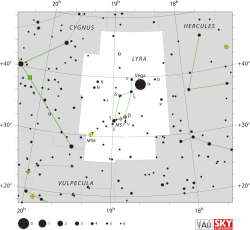Ny2 Lyrae
| Ny2 Lyrae (ν2) | |
 | |
| Observationsdata Epok: J2000.0 | |
|---|---|
| Stjärnbild | Lyran |
| Rektascension | 18t 49m 52,91721s |
| Deklination | 32° 33′ 03,8153″ |
| Skenbar magnitud ( V {\displaystyle V} ) | 5,23 |
| Stjärntyp | |
| Spektraltyp | A3 V |
| U–B | +0,12 |
| B–V | +0,10 |
| Astrometri | |
| Egenrörelse (µ) | RA: -11,12 mas/år Dek.: -11,90 mas/år |
| Parallax ( π {\displaystyle \pi } ) | 14,09 ± 0,25 |
| Avstånd | 231 ± 4 lå (71 ± 1 pc) |
| Detaljer | |
| Massa | 1,91 M☉ |
| Radie | 1,5 R☉ |
| Luminositet | 32 L☉ |
| Temperatur | 8 912 ± 303 K |
| Vinkelhastighet | 128 km/s |
| Ålder | 214 miljoner år |
| Andra beteckningar | |
| v 2 Lyr , 9 Lyrae, BD + 32° 3228, HD 174602, HIP 92405, HR 7102, SAO 67446. | |
Ny2 Lyrae (ν2 Lyrae, förkortat Ny2 Lyr, ν2 Lyr) som är stjärnans Bayerbeteckning, är en ensam stjärna belägen i den södra delen av stjärnbilden Lyran. Den har en skenbar magnitud på 5,23 och är svagt synlig för blotta ögat. Baserat på parallaxmätning inom Hipparcosuppdraget på ca 14,1 mas, beräknas den befinna sig på ett avstånd av ca 231 ljusår (71 parsek) från solen.
Egenskaper
Ny2 Lyrae är en blå stjärna i huvudserien av spektralklass A3 V. Den har en massa som är 1,9 gånger större än solens och en radie som är 1,5 gånger större än solens radie. Den utsänder från dess fotosfär 32 gånger mer energi än solen vid en effektiv temperatur på ca 8 900 K. Vid en beräknad ålder på 214 miljoner år roterar den med en prognostiserad rotationshastighet på 128 km/s, vilket ger stjärnan en ekvatorial utbuktning med en radie som är 5% större än polarradien.
Källor
Den här artikeln är helt eller delvis baserad på material från engelskspråkiga Wikipedia, tidigare version.Referenser
- ^ van Leeuwen, F. (2007), "Validation of the new Hipparcos reduction", Astronomy and Astrophysics, 474 (2): 653–664, Bibcode:2007A&A...474..653V, arXiv:0708.1752 Freely accessible, doi:10.1051/0004-6361:20078357.
- ^ Mermilliod, J.-C. (1986), "Compilation of Eggen's UBV data, transformed to UBV (unpublished)", Catalogue of Eggen's UBV data, SIMBAD, Bibcode:1986EgUBV........0M.
- ^ Royer, F.; et al. (February 2007), "Rotational velocities of A-type stars. III. Velocity distributions", Astronomy and Astrophysics, 463 (2): 671–682, Bibcode:2007A&A...463..671R, arXiv:astro-ph/0610785 Freely accessible, doi:10.1051/0004-6361:20065224.
- ^ David, Trevor J.; Hillenbrand, Lynne A. (2015), "The Ages of Early-Type Stars: Strömgren Photometric Methods Calibrated, Validated, Tested, and Applied to Hosts and Prospective Hosts of Directly Imaged Exoplanets", The Astrophysical Journal, 804 (2): 146, Bibcode:2015ApJ...804..146D, arXiv:1501.03154 Freely accessible, doi:10.1088/0004-637X/804/2/146.
- ^ Pasinetti Fracassini, L. E.; et al. (February 2001), "Catalogue of Apparent Diameters and Absolute Radii of Stars (CADARS)", Astronomy and Astrophysics (3rd ed.), 367: 521–524, Bibcode:2001A&A...367..521P, arXiv:astro-ph/0012289 Freely accessible, doi:10.1051/0004-6361:20000451.
- ^ McDonald, I.; et al. (2012), "Fundamental Parameters and Infrared Excesses of Hipparcos Stars", Monthly Notices of the Royal Astronomical Society, 427 (1): 343–57, Bibcode:2012MNRAS.427..343M, arXiv:1208.2037 Freely accessible, doi:10.1111/j.1365-2966.2012.21873.x.
- ^ "* nu. Lyr". SIMBAD. Centre de données astronomiques de Strasbourg. Hämtad 2017-03-15.
- ^ Eggleton, P. P.; Tokovinin, A. A. (September 2008), "A catalogue of multiplicity among bright stellar systems", Monthly Notices of the Royal Astronomical Society, 389 (2): 869–879, Bibcode:2008MNRAS.389..869E, arXiv:0806.2878 Freely accessible, doi:10.1111/j.1365-2966.2008.13596.x.
- ^ van Belle, Gerard T. (March 2012), "Interferometric observations of rapidly rotating stars", The Astronomy and Astrophysics Review, 20 (1): 51, Bibcode:2012A&ARv..20...51V, arXiv:1204.2572 Freely accessible, doi:10.1007/s00159-012-0051-2.
 )
) )
)